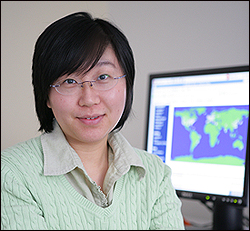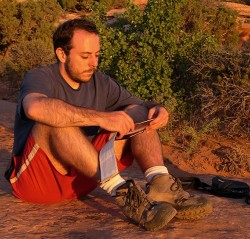An electrical engineer who is attempting to make wireless communications more reliable, an astronomer who studies the evolution of the cosmos by creating large numbers of virtual universes and a geologist who is studying the origins of super-eruptions have received the National Science Foundation’s Faculty Early Career Development awards.
According to the National Science Foundation, these prestigious, five-year awards are given to exceptionally promising college and university junior faculty who are committed to the integration of research and education and are likely to become the academic leaders of the 21st century.
Yuan Xue – Dynamic management of wireless networks

Recent headlines such as “Traffic Jam In the Ether” and “A Squeeze On Smartphones” illustrate the basic problem that Yuan Xue, assistant professor of computer science and computer engineering, is addressing in her research: the need to develop a better way to manage wireless networks.
Telecommunications companies have applied methods for utilizing their wireless resource that were developed for wired networks. That is one of the reasons for the prevalence of sluggish operation, dropped calls, weak signals and dead zones. The problem, known collectively as ‘mobile data congestion,’ is growing at an alarming rate as the number of smartphones and wireless tablets proliferate.
Responding by “over-provisioning” – building more cell towers and lobbying the federal government to give them additional regions in the radio spectrum – is not likely to work for wireless networks in the long run, Xue said. “Wireless networks are dramatically different from wired networks. They are much more dynamic and multi-faceted because the devices move around, signal strength varies from moment to moment and the requirements of devices like smartphones vary dramatically depending on the specific applications that are running. The classical resource application framework did not foresee the complexity and impact of dynamics in wireless network performance.”
The situation prompted Xue to develop a theoretical foundation for a dynamic-based approach for managing wireless networks by providing individual smartphones with the ability to vary their sending rate as the amount of traffic in their area varies in response to when the network is congested and allow smartphones to prioritize the communication requests that they receive from installed applications.
Most smartphones use digital technology and they transmit information in short bursts called packets. Currently, the devices automatically connect with the strongest signal that they receive. In reality, the signal strength fluctuates widely. During periods of congestion, the available bandwidth to each phone also changes dramatically and rapidly.
The packets that the phone sends when there is limited bandwidth are less likely to make it to the destination and so the phone has to retransmit them, adding to the congestion. On the other hand, there are times when the channel can handle more data than the phone is transmitting. So Xue would give smartphones the capability to monitor the available channel resource and vary their sending rate accordingly. This could reduce the amount of packet retransmission and increase the throughput substantially, she has calculated.
In addition, the information about how much traffic base stations are experiencing would allow the phone to lock onto the best channel to use, not simply the channel with the strongest signal.
Another topic Xue is exploring is the benefit of giving smartphones the ability to prioritize the transmission requests of its apps. Some apps, like phone calls or streaming video, need a nearly continuous stream of data. Others, like email or mapping programs aren’t nearly as demanding. Giving smartphones the ability to match these differing traffic demands against a varying wireless environment could improve their performance in many situations.
Xue will be testing her theories with a remote medical care system that is undergoing a clinical trial at the Vanderbilt University Medical Center.
NSF Grant 1150169
Andreas Berlind – Galaxies and dark matter

Andreas Berlind, assistant professor of physics and astronomy, is pushing the nation’s supercomputers to their limits to study the relationship between galaxy formation and the mysterious dark matter that we know very little about, except that it makes up about 85 percent of all the matter in the universe.
“We know that dark matter has formed high-density clumps, called ‘halos’, throughout the universe and their gravity has attracted hydrogen and helium atoms that condense to form stars and galaxies, but we don’t know many of the details about this process,” Berlind said.
In order to explore the relationship between galaxies and dark matter in unprecedented detail, Berlind will be combining the results from the latest observational surveys of the sky, which provide an extensive three-dimensional map of the universe, with a library of 200 simulated universes that his research group has created using the nation’s supercomputers over the past few years.
The sky surveys provide the spatial distribution of galaxies with unprecedented precision. The simulations provide the best information available about the distribution of dark matter. Comparing the two will allow the astronomers to determine if different types of galaxies, like spiral or elliptical galaxies, are associated with dark matter halos with specific properties, such as mass, density, concentration or shape.
“We won’t be able to do this for individual galaxies, because we cannot directly observe the dark matter around each galaxy. However, we can do statistical studies,” said Berlind. “For example, we can compare the spatial distribution of 100,000 spiral galaxies and 100,000 red elliptical galaxies to the spatial distribution of dark matter halos, and deduce the average relationship between galaxy type and dark matter halo mass. This will give us new insights into how different types of galaxies formed.”
In addition, Berlind will use the award to create a series of astronomy programs at the K-12, undergraduate and graduate levels designed to encourage students from underrepresented groups to study physics and astronomy. A key feature of this plan will be to support the Fisk-Vanderbilt Masters-to-PhD Bridge Program that helps underrepresented minority students obtain doctoral degrees in physics and astronomy. The students get their masters degree from traditionally black Fisk University and complete their doctoral degrees at Vanderbilt.
NSF Grant 1151650
Guilherme Gualda – Supervolcanoes

The evolution of supervolcanoes – enormous volcanic eruptions that make normal eruptions like Mount St. Helens seem like minor hiccups – is the subject of the research of Guilherme Gualda, assistant professor of earth and environmental sciences.
These volcanic eruptions, which eject more than 100 times the amounts of material than a normal eruption onto Earth’s surface (more than 240 cubic miles of ash and molten rock) in a matter of days to weeks, have the potential to end civilization. The only other natural disaster that shares this dubious distinction is the strike of a large meteorite.
Fortunately, super-eruptions have been extremely rare. The last one occurred 26,000 years ago. The largest known historic eruption – the eruption of Tambora that took place in 1815 and led to the “Year without a summer” in North America and Europe in 1816 was about one tenth the size of a super-eruption.
Super-eruptions are produced by the creation of exceptionally large bodies of molten rock – much larger than any known to exist today – that form a few miles below the surface.
Last May, Gualda published a study of Bishop Tuff, the remnants of the giant magma body that produced a super-eruption in Long Valley, CA about 760,000 years ago. By analyzing the patterns of crystals and small voids called vesicles that are caused by gas bubbles trapped in the rock, he concluded that the giant magma body formed between a few thousand to a few hundred years before the eruption. The conclusion was based on the latest methods of analysis but contradicts the previous assumption that such super-large magma bodies simmered for hundreds of thousands of years before erupting.
“When we first got this result, we didn’t believe it,” said Gualda. “So we ran a number of additional tests, all of which confirmed our initial result.”
With the support of the new grant, Gualda will apply these techniques to study the remnants of three super-eruptions in four continents in an attempt to answer several fundamental questions about giant magma bodies: What are the timescales over which they form? What causes the transition from a quiet state to the vigorous eruptive state that ultimately leads to a super-eruption? What can we learn from studying crystal and vesicle populations?
The study will focus on 3 deposits spread over 4 continents: Huckleberry Ridge Tuff created by a super-eruption that took place 2.1 million years ago and formed by Island Park Caldera that lies partially in Yellowstone Park, Oruanui Tuff on the North Island of New Zealand caused by a super-eruption in the Taupo Volcanic Zone 27,000 years ago and the Paraná-Etendeka rhyolites, which are the result of several eruptions – possibly some of the largest known on Earth – that took place just prior to the opening of the South Atlantic between what is now South America and West Africa.
Field research will be accompanied by teaching summer session courses in southern Brazil, Namibia and New Zealand, formally offered by Vanderbilt University. These courses are designed to provide global and international experiences of collaborative research and learning on the part of faculty and students from universities from the US, Brazil and New Zealand.
NSF Grant 1151337